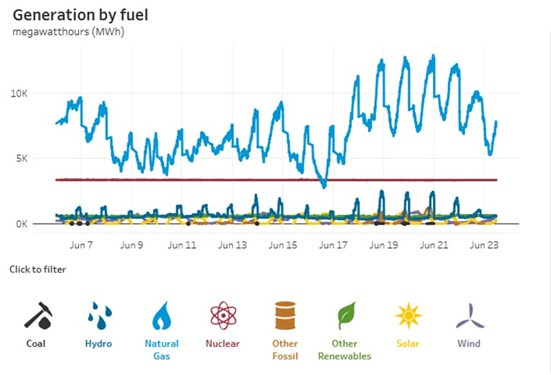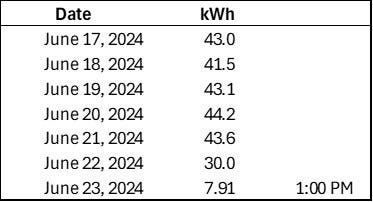Energy Musings - June 23, 2024
New England is emerging from its recent heat wave. The EIA showed just how much power demand rose with heat's arrival. We also looked at supply with a focus on solar.
Power And New England’s Heat Wave
The Energy Information Administration posted a story this weekend on its website highlighting the impact of last week’s East Coast heat wave on electricity demand in New England. The article contained a chart of hourly electricity demand for the Independent System Operator - New England (ISO-NE) that regulates the six-state region’s power grid.
ISO-NE’s power demand soared last week with the arrival of a heat wave nearly reaching the forecasted peak demand for the summer.
The EIA chart showed how much power demand in New England rose with the arrival of the heat. According to EIA figures, the region’s peak electricity demand of 23,324 megawatt-hours (MW) was at 7 pm on Thursday, June 20. That day’s peak demand was 521 MW above the peak at 6 pm on Wednesday, June 19.
These demand peaks were slightly under the 24,553 MW peak forecast by ISO-NE in its June 6 Summer 2024 Assessment Report. Peak electricity demand last year was 24,042 MW, meaning ISO-NE expects peak demand to rise 2.1% this year.
The region met its power needs by burning more natural gas. Gas consumption hit 2 billion cubic feet per day, compared with a gas burn of 1.20 bcf/d on Wednesday and Thursday of the prior week.
ISO-NE was forced to declare a Power Caution on Tuesday evening (6/18) after unexpected generation outages. The caution was lifted at 10 pm when consumer demand declined.
We were interested in what impact solar power may have had on New England’s power supply. The following chart shows the region’s power by fuel source for the same period as the demand chart. Solar is a small contributor, but we noticed its contribution has fallen in recent days.
Natural gas was ISO-NE’s hero in helping avoid power blackouts.
Using data from our Rhode Island summer home rooftop solar system, we see the same phenomenon as appears in the EIA chart. Rhode Island Electric purchases the output of our rooftop solar system, so it was included in the region’s solar supply.
Saturday (6/22) and Sunday (6/23) saw a significant decline in solar output from prior days’ supply. We only had data as of 1 pm on Sunday as we wrote this article. With the sun finally emerging from the fog and clouds dominating the area this weekend, we expect our Sunday output will rise during the afternoon.
Cloudy and foggy Saturday and Sunday cut our solar system’s output which the local utility purchases.
Once again, relying on renewable energy to power regional electricity grids can be risky. Dispatchable natural gas power saved ISO-NE from rolling brownouts. Here’s hoping the rest of the summer will be as fortunate.







l agree with KIt. The trick will be to convince the people who have not yet formed an opinion on the future of fossil fuels in the energy mix. The climate change crowd is relentless in its attack on fossil fuels, and its denial of the consequences of trying to eliminate them economically from the energy mix. They are willing to cut off everybody's nose but their own to spite the collective face. Evidence is immaterial to them. Allen and others like him give us the ammo we need to refute their collective delusion. Thanks for another good Musings, Allen!